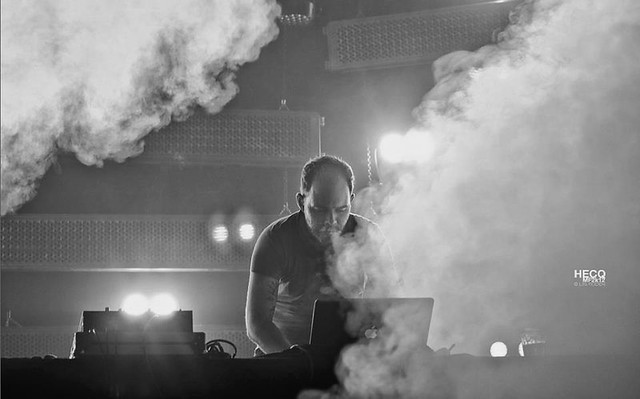BleeD at Cafe Oto // Bee Mask & Vessel

BleeD returned to Café Oto last Saturday with another bill of enterprising electronic music, beat-oriented and otherwise; with the main billing belonging to Philadelphia-based Bee Mask. Bee Mask is the alias of Chris Madak, previosuly a journeyman of some of the US underground’s most essential cassette and CDR labels, and now with three releases under his belt on the excellently curated Editions Mego offshoot Spectrum Spools, including last year’s When We Were Eating Unripe Pairs LP. Opening proceedings was Left Blank and Tri Angle signee Sebastian Gainsborough, better known as Vessel, whose shimmering take on house and techno felt a bit muted in the serene candlelit surrounds of Café Oto. With most of the audience seated, Vessel decided to follow by example and sat on the concrete floor behind various electronics. It felt a little voyeuristic from the audience – like watching someone messing about with a circuit board in their bedroom – and it felt quite detached. Presumably Gainsboruough felt a similar estrangement, as music so suited to audience participation is bound to be stilted in too formal a setting.
Nonetheless, both sets were intriguing and covered a lot of sonic territory. Particularly in the case of Bee Mask, whose ostensibly minimal set up of a laptop and a sampler/sequencer was responsible for producing a diverse world of sounds. Opening with a synth arpeggio that echoed the languid works of Roedelius, the first piece developed into a balmy and dense series of drones. The samples of various found sounds and instruments in addition to purely electronic tones was redolent of the music of Concern, another contemporary creator of such layered drones and nomad of the US underground.
The opening piece came to an abrupt and somewhat humorous finish, and the performance as a whole covered ground that saw it go from beautifully melancholic to hilarious, with Madak’s theatrical gestures adding a comic lightness to the already warm and inviting soundtrack. However Madak’s music goes beyond mere welcoming ambience, and the moments of kaleidoscopic Iasos-esque reverie were balanced with darker and more intense segments. It’s music filled with a delight at sounds in themselves, taking them as being complete in as they are and not just utilitarian tools. In fact, Madak has spoken in interviews about not wanting his music generally to serve any particular purpose or to be an escape, but rather be a ‘layer of lived reality’; and in his music there is a real sense of the world being thrown out in front of us bare for our contemplation.
Both on record and live, in the layered and more overwhelming moments, each individual sound has a certain opacity and does more than simply contribute to the complete picture and to a given emotional end. In the latter half of the performance, when things became more sparse and less ordered, each texture became even more accentuated and fascinating than it would have been otherwise. I was struck by what sounded like a bell, which reappeared several times throughout, and which conjured visions of some far off railway station, as if experienced in memory. The sublimity of Madak’s music often lies in its ability to evoke images of fantastical worlds, with soundscapes so dense and varied that they provide a set of tools for the freeplay of the listener to imagine a host of different scenes. However, as Madak has stressed, his music is rooted in the world as it is; and despite the imaginative potential of it, it is more than some functional soundtrack to a lysergic daydream. Madak’s gestures as he performed, and the lack of visual accompaniment (something similar artists often rely upon), staved off the temptation to drift out of focus, and instead let the wide array of sounds being presented dictate the audience’s engagement.
- Published
- Jun 2, 2013
- Credits
- Words by Rob Heath
